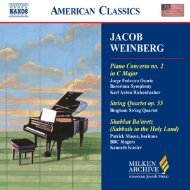Download Liner Notes PDF - Milken Archive of Jewish Music
Download Liner Notes PDF - Milken Archive of Jewish Music
Download Liner Notes PDF - Milken Archive of Jewish Music
- No tags were found...
You also want an ePaper? Increase the reach of your titles
YUMPU automatically turns print PDFs into web optimized ePapers that Google loves.
Russian music. However, around 1911 he became attractedto the work and mission <strong>of</strong> the Gesellschaft circle, intriguedby its reactions to the musical assimilation <strong>of</strong> many Russian-<strong>Jewish</strong>composers who demonstrated an obliviousnessto <strong>Jewish</strong> roots. Solomon Rosowsky (1878–1962), president<strong>of</strong> the main St. Petersburg section <strong>of</strong> the Society, becamefriendly with Achron after hearing him play, introducinghim to the Gesellschaft’s activities and its discovery<strong>of</strong> <strong>Jewish</strong> heritage and folklore as a source <strong>of</strong> artisticcreativity. Achron joined the Gesellschaft that year andlater became chairman <strong>of</strong> its music committee. Rosowskywas his mentor, a relationship that continued throughouttheir lives after both had moved to the United States.Achron’s first composition following his joining the Gesellschaftwas his Hebrew Melody for violin and piano (op.33,1911) based on a theme he remembered hearing in aWarsaw synagogue in his youth. It remains his most famouspiece, part <strong>of</strong> the standard repertoire <strong>of</strong> virtually all concertviolinists and a frequent encore number. It has beenplayed and/or recorded by Heifetz, Milstein, Elman, HenrykSzeryng, and Itzhak Perlman, and it usually provides theprimary recognition <strong>of</strong> Achron’s name in the classicalmusic world. It was first performed in St. Petersburg in 1912at a ball-concert given by an adjutant to the czar, whereAchron played it as an encore after a program <strong>of</strong> classicalworks. The immediate success <strong>of</strong> Hebrew Melody actuallychanged the course <strong>of</strong> Achron’s musical life, since from thatpoint on, he devoted a significant part <strong>of</strong> his energies andgifts to music with <strong>Jewish</strong> connections. His next piece was aballad on Hebrew themes for cello and piano, Hazzan (op.34). A number <strong>of</strong> pieces related to <strong>Jewish</strong> themes followed:Three Pieces on <strong>Jewish</strong> Folksongs; Hebrew Dance; HebrewLullaby; Dance Improvisations; Variations on El yivne hagalil,for piano; and To the Jewess.Achron became preoccupied with developing a “<strong>Jewish</strong>”harmonic and contrapuntal idiom that would be moreappropriate to <strong>Jewish</strong> melodies than typical Westerntechniques, but he opposed the notion <strong>of</strong> an artificiallysuperimposed “<strong>Jewish</strong> style.” He was convinced that anypossible stylistic development <strong>of</strong> a <strong>Jewish</strong> national artmusic required an evolutionary course, just as Westernmusic had evolved over centuries. In his essay “On <strong>Jewish</strong><strong>Music</strong>,” he wrote that any serious <strong>Jewish</strong> art music must“be developed by gradual assimilation” and that if <strong>Jewish</strong>composers were to express their own <strong>Jewish</strong> experiencesmusically, the creative product would be “welcome andaccepted as an important and integral part <strong>of</strong> music as awhole.” That is, any <strong>Jewish</strong> national art music—music pertainingto <strong>Jewish</strong> experience as a people—must first standas music, and then as a subset <strong>of</strong> cultivated Western music,rather than the reverse. In this he presaged misunderstoodsentiments articulated decades later by composer HugoWeisgall, who said that for serious music to be “<strong>Jewish</strong>,” itfirst had to be “good music.” Achron rejected as naïve anychauvinistic perceptions <strong>of</strong> “purity” and “authenticity.”“Such purity does not and cannot exist,” he wrote. “Thisis as true <strong>of</strong> art as <strong>of</strong> life’s other constituents, since interinfluencesare not only unavoidable but desirable.”During the First World War, Achron served in the RussianImperial Army and saw action at the Western Front. Hethen joined the music corps <strong>of</strong> the Russian army and washeadquartered in Petrograd. After Russia’s exit from thewar and during the first few years following the OctoberRevolution, he continued his performing career and beganto solidify his reputation as a composer. In 1922 he movedto Berlin, where, with a few other émigré colleagues, hetried to replant the Gesellschaft, which had disbandedafter the Revolution. Among his major works <strong>of</strong> thatperiod is Children’s Suite, based on motives <strong>of</strong> biblical cantillations.Achron became increasingly attracted to bothbiblical cantillation and secular <strong>Jewish</strong> folksong as sourcesfor compositions, but unlike many <strong>of</strong> his colleagues, hegrew less interested in Hassidic music as a mine fromwhich to draw.While in Berlin, Achron became interested in the work <strong>of</strong>the Habima (Hebrew) theatrical studio, which inspired hisoriginal score for Belshazzar. His Berlin experience provedto be short-lived, and in 1924 he went to Palestine forseveral months, as did many former Gesellschaft associates.That visit had a pr<strong>of</strong>ound effect on his subsequentmusic, both spiritually and in terms <strong>of</strong> various melodies,modes, and cantillations he heard for the first time. Hecame to America in 1925—first to Chicago, and then NewYork for nine years. Although he devoted himself evermore diligently to composition during those years, he stillperformed frequently. At an eightieth birthday tribute toLeopold Auer at Carnegie Hall, Heifetz, Zimbalist, and thehonoree played Achron’s cadenza in their performance<strong>of</strong> a Vivaldi concerto for three violins (a concert that alsoincluded performances by Sergei Rachmanin<strong>of</strong>f, JosephH<strong>of</strong>fman, Ossip Gabrilowitch, and other supreme giants <strong>of</strong>the music world <strong>of</strong> the time).In New York, Achron wrote several scores <strong>of</strong> incidentalmusic for productions at Maurice Schwarz’s Yiddish ArtTheater, building on his Berlin experiences with Habimaand the Teatron Eretz Israeli. Among the plays for which hewrote music were Goldfaden’s The Tenth Commandment,Leivick’s The Golem, Sholom Asch’s The Witch <strong>of</strong> Castille,and two by Sholom Aleichem: Kiddush hashem and Stempenyu.The score for the last was later reworked into apiece for violin and piano with the same title, premiered by5 8.559408
















